Gershwin – An American in Paris (2016)
George Gershwin (1898 — 1937): An American in Paris
Instrumentation: 3 flutes, 3rd doubling piccolo, 2 oboes, English horn, 2 clarinets, bass clarinet, alto saxophone, baritone saxophone, tenor saxophone, 2 bassoons; 4 horns, 3 trumpets, 3 trombones, tuba; timpani, bass drum, crash cymbals, glockenspiel, large tom tom, small tom tom, snare drum, taxi horns of different pitches, triangle, wood block, xylophone; strings
Performance time: 17 minutes
Background
Gershwin composed An American in Paris in 1928, when he was not quite 30, on commission from the New York Philharmonic. For those of us who know his songs best, this sparkling ballet score-cum-tone poem is one of the best gateways to his skill as a composer in the classical mold. No composition by Gershwin or anyone else can beat it for its energetic, exuberant expression of love for a city and for life itself.
The fabled lifestyle of the expat artist in Paris — smoking, arguing in cafés, plying one’s craft — really did exist. Many Hollywood films, including Woody Allen’s recent Midnight in Paris, have offered seemingly romanticized views of the American artist’s pilgrimage to the Paris of the 1920s and ’30s for self-discovery and artistic development. It was updated to the post-World War II era for the film An American in Paris, which features the complete tone poem as the musical accompaniment for a 14-minute ballet choreographed by the film’s star, Gene Kelly. A staged version of the film is currently a hit musical on Broadway.
What to Listen For
An American in Paris is rhapsodic and buoyant, a combination of characteristically French textures and can-can rhythms, a traditional tune or two, and Gershwin’s usual melodic and harmonic inventiveness. It’s not surprising that Gershwin manages to make American blues scales sound Gallic, as French composers were already using the flatted third and seventh notes of the scale in their own works. Besides, remember — this is an American in Paris, so we hear the Parisian scene through Yankee ears.
The work is structured in five rough sections that form a loosely arched structure, A-B-A in form. But it is best heard without an awareness of these formal elements. Gershwin’s music takes us through time and space, bringing Paris to life in a way that is as real as being there — perhaps more so. It takes us to jazz joints and dance clubs, and it begins with one of the most vivid streetscapes in all of music, an evocation of a Parisian traffic jam that is simultaneously beautiful and hilarious in its verisimilitude. Listeners who are old enough, and who grew up in the right neighborhood, may remember the lyrics “my mother gave me a nickel to buy a pickle,” inspired by one of the can-can melodies that Gershwin quotes.












